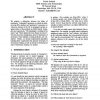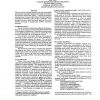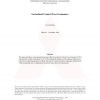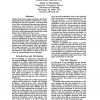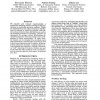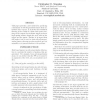ACL
1993
14 years 24 days ago
1993
We propose a distinction between two kinds of metonymy: "referential" metonymy, in which the referent of an NP is shifted, and "predicative" metonymy, in which...
ACL
1993
14 years 24 days ago
1993
1 Efficient natural language generation has been successfully demonstrated using highly compiled knowledge about speech acts and their related social actions. A design and prototyp...
ACL
1993
14 years 24 days ago
1993
This paper introduces a tree generating system called Lexicalized Context-Free Grammar (LCFG) and describes a cubic-time parser for it. LCFG embeds the elegance of the analyses fo...
ACL
1993
14 years 24 days ago
1993
This paper describes the problems faced while using Kimmo's two-level model to describe certain Indian languages such as Tamil and Hindi. The two-level model is shown to be d...
ACL
1993
14 years 24 days ago
1993
This paper examines the current performance of the stochastic tagger PARTS (Church 88) in handling phrasal verbs, describes a problem that arises from the statistical model used, ...
ACL
1993
14 years 24 days ago
1993
When human tutors engage in dialogue, they freely exploit allaspects of the mutually known context, including the previous discourse. Utterances that do not draw on previous disco...
ACL
1993
14 years 24 days ago
1993
We describe and evaluate experimentally a method for clustering words according to their distribution in particular syntactic contexts. Words are represented by the relative frequ...
ACL
1993
14 years 24 days ago
1993
Certain spans of utterances in a discourse, referred to here as segments, are widely assumedto form coherent units. Further, the segmental structure of discourse has been claimed ...
ACL
1993
14 years 24 days ago
1993
Interpreting fully natural speech is an important goal for spoken language understanding systems. However, while corpus studies have shown that about 10% of spontaneous utterances...
ACL
1993
14 years 24 days ago
1993
This paper presents a new method for producing a dictionary of subcategorization frames from unlabelled text corpora. It is shown that statistical filtering of the results of a �...
